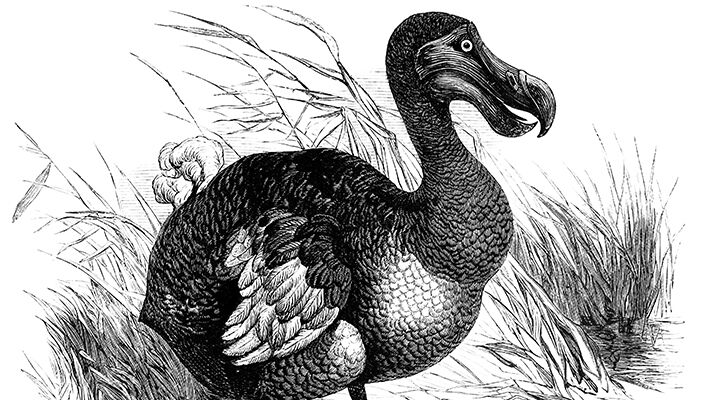
The Dodo’s Posthumous Message to Mankind
In 1681, the last dodo bird on the planet breathed its last breath. But that was not the final chapter of the bird’s story.
Some 300 years later, botanists on Mauritius—the island where the dodo had lived—noticed that a certain species of tree was rapidly dying off. Tambalacoque trees had historically grown in abundance on Mauritius, but by the 1970s only 13 remained. And all of those remaining were thought to be around 300 years old. Even though they were producing fruit containing seeds each year, none of the seeds were sprouting into saplings.
This meant that no new Tambalacoque trees had sprouted since the late 1600s.
The Tambalacoque’s average lifespan is roughly 300 years, so the last trees of the species were very near the end of their lives. Once those 13 died, the Tambalacoque would be just like the dodo—extinct.
An American ecologist named Stanley Temple wondered if the dodo’s extinction 300 years earlier was connected to the Tambalacoque’s inability to reproduce, which had also set in about 300 years earlier.
Temple traveled to Mauritius to study the Tambalacoque, and made a fascinating discovery: When the dodos were still alive, they would eat the Tambalacoque’s fruit, and only after the seeds had journeyed through their digestive tract could they successfully germinate.
Researcher and writer Robert Doolan explained the discovery:
The tree’s seeds are encased in a thick-walled protective coat, but the dodo’s stone-filled gizzard was able to exert a powerful crushing pressure on them. The bird’s gizzard (a second stomach for grinding food) would pound away at the seed’s coat, weakening it and cracking it a little, but not enough to damage the seed inside. When eventually deposited by the dodo, the seed was able to germinate.
After making this discovery, Temple found a solution to the Tambalacoque’s decline. He brought some American turkeys to Mauritius, and found that their digestive process was similar enough to that of the dodos to be able to activate the Tambalacoque seeds. Thanks to Temple and the turkeys, the Tambalacoque lives on to this day!
The dodo went extinct back in 1681, but 300 years later, it delivered a posthumous message to mankind: The Tambalacoque and the dodo bird likely would had to have come into existence at the same time in order for the Tambalacoque to survive.
This message presents some potential problems for the evolutionary theory. Evolutionists say large trees evolved some 360 million years ago, while the ancestors of today’s birds “arrived comparatively late”—about 65 million years ago. That would likely have left the Tambalacoque tree with no way to germinate its seeds for some 300 million years. (There is some evidence that other animals such as turtles also ate and activated the seeds, but it didn’t seem to be sufficient to offset the decline of the tree that set in after the dodo’s extinction.)
The dodo’s message challenges the random mutation theory of evolution—and on this front the bird does not stand alone.
In each of these cases, the brilliance of the Creator is on display. The intricacy of His physical creation is clear. And the account of how He created Earth’s sophisticated ecosystems is confirmed.
For those who believe in the biblical account of Creation, this example can fortify the belief. However, the dodo-Tambalacoque relationship can not be viewed as proof against the theory of evolution, and it should come as no surprise that evolutionists have different explanations for such biological relationships. There’s no shortage of dissertations explaining how such dependencies could have gradually happened over eons as the organisms evolved. Many impressive books explain how it is all still the result of chance mutations. And powerful rebuttals discredit the findings of Temple and other such discoveries.
In many cases, their logic is remarkable, but the premise from which they start is flawed.
In the centuries leading up to the Scientific Revolution, the Catholic Church reigned as the chief authority and knowledge source for much of the world. The clergy generally viewed scientists and their discoveries as a threat to Catholic doctrine. Church officials sometimes embarrassed the church by trying to defend mistaken church teachings such as geocentrism, which science offered empirical evidence against.
Competition between science and religion heated up. For some in the science camp, the desire to undermine church authority became the main motivation. Some scientists challenged God’s very existence as a way to discredit the foundation of religion. Such reasoning spawned the evolutionary theory. Its proponents sometimes undertake studies with that conclusion already firmly in mind. Whatever they can contort into supporting the arguments for evolution, they keep. All else they often reject or downplay.
When society’s most impressive minds all seem to agree that evolution is fact, it can become difficult for us to keep our faith from going the way of the dodo. But that doesn’t have to be the case. To bolster your faith in the Creator, set aside some time to study our free booklet Does God Exist?
